Crop Protection :: Cash Crop :: Pest of Cotton
 |
Crop: cotton
Scientific name: Gossypium spp
Family: Malvaceae
|
Major pests of Cotton
| |
1.Fruit borer: Helicoverpa armigera |
Symptoms of damage
- Bolls showing regular, circular bore holes
- Larvae seen feeding on the boll by thrusting their heads alone inside and leaving the rest of the body outside
- Presence of granular faecal pellets outside the bore hole.
- A single larva can damage 30-40 bolls.
|
 |
| Feeding injury |
|
Identification of the pest
- Eggs - Spherical in shape and creamy white in colour, present singly
- Larva - Shows colour variation from greenish to brown.
- It has dark brown grey lines on the body with lateral white lines and also has dark and pale bands.
- Pupa - Brown in colour, occurs in soil, leaf, pod and crop debris
- Adult
- Light pale brownish yellow stout moth.
- Forewings are olive green to pale brown in colour with a dark brown circular spot in the centre.
- Hind wings are pale smoky white with a broad blackish outer margin.
|
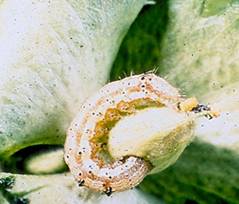 |
| Circular bore hole |
|
|
Management
ETL: One egg or one larva /plant
- Monitoring :
Pest monitoring through light traps, pheromone traps and in situ assessments by roving and fixed plot surveys has to be intensified at farm, village, block, regional and State levels. For management, an action threshold of one egg per plant or 1 larva/ plant may be adopted.
Cultural practices :
- Synchronised sowing of cotton preferably with short duration varieties in each cotton ecosystem.
- Avoid continuous cropping of cotton both during winter and summer seasons in the same area as well as ratooning.
- Avoid monocropping. Growing of less preferred crops like greengram, blackgram, soyabean, castor, sorghum etc., along with the cotton as intercrop or border crop or alternate crop to reduce the pest infestation.
- Removal and destruction of crop residues to avoid carry over of the pest to the next season, and avoiding extended period of crop growth by continuous irrigation.
- Optimising the use of nitrogenous fertilizers which will not favour mthe multiplication of the pest.
- Judicious water management for the crop to prevent excessive vegetative growth and larval harbourage.
Biological control :
- Application of Nuclear Polyhedrosis Virus (NPV) at 3 x 10 12 POB /ha in evening hours at 7th and
12th week after sowing.
- Conservation and augmentation of natural predators and parasitoids for effective control of the pest.
- Inundative release of egg parasitoid, Trichogramma spp., at 6.25 cc/ha at 15 days interval 3 times from 45 DAS
- Egg-larval parasitoid, Chelonus blackburnii and Predator Chrysoperla carnea at 1,00,000/ha at 6th, 13th and 14th week after sowing.
- ULV spray of NPV at 3 x 10 12 POB /ha with 10% cotton seed kernel extract, 10% crude sugar, 0.1% each of Tinopal and Teepol for effective control of Helicoverpa.
- Note: Dicofol, methyl demeton, phosalone are comparatively safer to Chrysoperla larva
recording low egg mortality.
Chemical control :
- Discourage the indiscriminate use of insecticides, particularly synthetic pyrethroids.
- Use of proper insecticides which are comparatively safer to natural enemies such as endosulfan, phosalone, etc., at the correct dosage and alternating different groups of insecticides for each round of spray.
- Avoid combination of insecticides as tank mix.
- Adopt proper delivery system using spraying equipments like hand compression sprayer, knapsack sprayer and mist blower to ensure proper coverage with required quantity of spray fluid and avoid ULV applications or Akela spray applications.
- Proper mixing and preparation of spray fluid for each filling of spray fluid tank.
At early stages of square formation apply one of the following insecticides
- Acephate 75%SP 780 g/ha
- Azadirachtin 0.03% EC 500 ml/ha Carbaryl
10%DP 25 kg/ha Chlorantraniliprole 18.5%
SC 150 ml/ha Chlorpyriphos 20% EC 1250
ml/ha Diflubenzuron 25%WP 300 g/ha
- Emamectin benzoate 5% SG 190-220 g/ha
- Fipronil 5%SC 2000 ml/ha
- Flubendiamide 20%WG 250 g/ha
- Flubendiamide 39.35%SC 100-125 ml/ha
- Indoxacarb 14.5%SC 500 ml/ha
- Lufenuron 5.4%EC 600 ml/ha
- Novaluron 10%EC 1000 ml/ha
- NPV of H. armigera 0.43% AS 400-600 ml/ha
- Profenofos 50% EC 1750-2500 ml/ha
- Pyridalyl10%EC 1500-2000 ml/ha
- Spinosad 45.0%SC 165-220 ml/ha
- Thiodicarb 75%WP 1000 g/ha
During bolling and maturation stage, apply any one of the following insecticides (1000 l of spray fluid/ha):
- Quinalphos 25 EC 2.0 l/ha
- Carbaryl 50 WP 2.5 kg/ha
- Pyraclofos 50 EC 1.5 l/ha
Biological control:
- Bacillus thuringiensis-k 750-1000 g/ha
- Bacillus thuringiensis serovar kurstaki (3a,3b,3c) 5%WP 500-1000 g/ha
- Beauveria bassiana 1.15% WP 400 g/ha
|
| |
2. Pink bollworm: Pectinophora gossypiella |
Symptoms of damage
- Rosetted flowers
- The holes of entry plugged by excreta of larvae which are feeding inside the seed kernels.
- They cut window holes (interlocular burrowing) in the two adjoining seeds thereby forming "double seeds"
- The attacked buds and immature bolls drop off.
- Discolored lint and burrowed seeds.
|
 |
Identification of the pest
Larva
- Shows colour variation young larva white and late instar almost black, brown or green to pale or pink
- several dark and light alternating bands running the entire length
Adult
- Small moth.
- Forewings arebrown or dull yellow olive grey with dark spots on the forewing.
- Hind wings margins are deeply fringed.
|
 |
Management
ETL: 10% infested fruiting parts
- Use pheromone trap to monitor the adult moth activity
- Three weekly releases of egg parasitoid Trichogrammatoidea bactrae @ 1,00,000/ha per release
coinciding the incidence of the pest.Dust carbaryl 5%D 20 kg/ha
Spraying any one of the following insecticides:
- Phosalone 35%EC 2000 ml/ha
- Triazophos 40EC 2.5l/ha
|
| |
3. Spotted bollworms: Earias vittella, Spiny bollworm: Earias insulana |
Symptom of damage
- Drying and drooping of terminal shoots during pre –flowering stage
- Shedding of squares and young bolls
- Flaring up of bracts during square and young boll formation stage
- Holes on bolls and rotting of bolls.
|
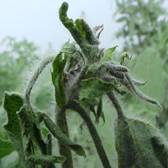 |
 |
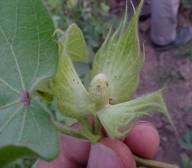 |
Drying - terminal shoots |
Bore holes and rotting |
Flared square |
|
Identification of the pest: E. vitella
- Larva - Brownish with white streaks dorsally and pale yellow ventrally, Without finger shaped processes
Adult
- Small buff coloured. 0
- Forewings are pea green with a wedge shaped white band running from base to out margin
Identification of the pest: E. insulana
Larva – Brown with dorsum showing a white median longitudinal streak.
The last two thoracic segments and all the abdominal segments have two pairs of fleshy tubercles (finger shaped processes) one dorsal and the other lateral
Pupa - Brown and boat shaped
Adult - Small buff coloured. Forewingsare uniformly silvery green
|
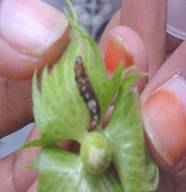 |
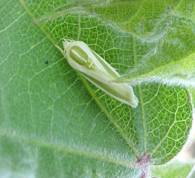 |
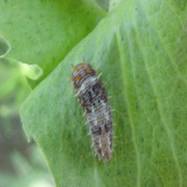 |
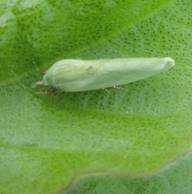 |
E. vitella - Larva |
E. vitella - Adult |
E. insulana - Larva |
E. insulana - Adult |
|
Management
ETL: 10% infested shoots / squares / bolls
- Spraying any one of the following insecticides
- Carbaryl 5%DP 20 kg/ha
- Chlorantraniliprole 18.5% SC 150 ml/ha
- Flubendiamide 39.35%SC 100-125 ml/ha
- Indoxacarb 14.5%SC 500 ml/ha
- Phosalone 35%EC 1714ml/ha
- Profenofos 50% EC 1500-2000 ml/ha
- Triazophos 40%EC 1500-2000 ml/ha
Biological control:
- Bacillus thuringiensis serovar kurstaki (3a,3b,3c) 5%WP 750-
1000 g/ha
|
| |
4. Cotton Stem Weevil: Pempheres (Pempherulus) affinis |
Symptoms of damage
- Swellings on the stem just above the ground level.
- Young plants are invariably killed
- Older plants that survive, lack vigor and strength, and when strong winds blow, these plants sometimes break at the nodes.
|
|
|
|
Stem gall |
Stem galls |
Grub |
|
Identification of the pest
- Larva - Grub, white in colour without leg (apodous)
- Adult - Very small weevil, dark in colour with two small white patches on the elytra
|
Management
- Basal application of FYM 25 t/ha and 250 kg/ha of neem cake.
- Seed treatment with chlorpyriphos 20 EC @ 10ml/kg of seed+ Drenching collar region with chlorpyriphos 20 EC @ 2.5ml/ l on 15 and 30 DAS+ Earthing up.
Spray any one of the following insecticides
- Carbaryl 10%DP 25 kg/ha
- Carbofuran 3%CG 33.3 kg/ha
|
| |
5. Shoot weevil: Alcidodes affaber |
Symptoms of damage
- Terminal shoots with galls
- Bore hole surrounded by raised margins
|
Identification of the pest
- Adult - Weevil dark greyish brown with pale cross bands on the elytra
|
Management
- Soil application of Carbofuran 3 G @ 30 kg may be done on 20 days after sowing and earthed up.
- Basal application of FYM 25 t/ha or 250 kg/ha of neem cake.
|
| |
6. Stem borer: Sphennoptera gossypii |
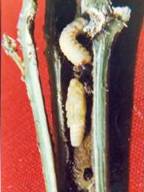 |
 |
Symptoms of damage
- Plants with drooping leaves,
- Wilting in patches
Identification of the pest
- Adult - Dark brown jewel beetle
Management
- Soil application of Carbofuran 3 G @ 30 kg may be done on 20 days after sowing and earthed up.
- Basal application of FYM 25 t/ha or 250 kg/ha of neem cake.
|
Affected stem |
Infested plants |
|
|
| |
7. Leaf roller: Sylepta derogata |
Symptom of damage
- Leaves rolled in the form of trumpets fastened by silken threads
- Marginal portion of leaves eaten away
- Plants defoliated in severe attack
|
|
|
|
Rolled leaves |
Larva |
Adult |
|
Identification of the pest
- Larva - Bright green (glistening) with dark head and prothoracic shield.
- Adult - Moth with yellow wings having brown wavy markings
Managment
- Collection and destruction of sheded plant parts.
- Hand picking and destruction of grown up caterpillars.
- Spray any one of the following insecticides
- chlorpyriphos 20 EC 2.0 l/ha
- dichlorvos 76 WSC 1 lit/ha
- fenitrothion 50 EC @ 625 ml.
|
| |
8. Tobacco Cutworm: Spodoptera litura |
 |
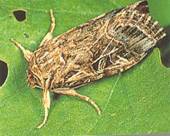 |
Symptoms of damage
- Scrapping the epidermal layer, leaving the skeleton of veins of leaf
- During severe attack, only the stem and side shoots will be standing in the field without any leaf or bolls
- Larvae feed the leaves by making small holes.
|
|
Identification of the pest
- Egg - Laid in masses which appear golden brown
- Larva - Pale greenish with dark markings.
- Gregarious in the early stages
Adult
- Forewings – brown colour with wavy white marking
- Hindwings- white colour with a brown patch along the margin
|
Management
ETL: 8 egg masses/100 m row
- Use of light trap to monitor and kill the attracted adult moths.
- Set up the sex pheromone trap at 12/ha to monitor the activity of the pest and to synchronise the pesticide
application, if need be, at the maximum activity stage.
- Growing castor along border and irrigation bunds.
- Removal and destruction of egg masses in castor and cotton crops.
- Removal and destruction of early stage larvae found in clusters which can be located easily even from a distance.
- Collection and destruction of shed materials.
- Hand picking and destruction of grown up caterpillars.
- Spray any one of the following insecticides per ha using, a high volume sprayer covering the foliage and soil surface :
- Chlorpyriphos 20 EC 2.0 l
- Chlorpyriphos 20 EC 1.25 l
- Chlorantraniliprole 18.5% SC 150 ml
- Diflubenzuron 25%WP 300-350 g
- Spraying of insecticides should be done either in the early morning or in the evening and virus in the evening.
- Use of poison bait pellets prepared with rice bran 12.5 kg, jaggery 1.25 kg, carbaryl 50% WP 1.25 kg and water 7.5 litres. This bait can be spread in the fields in the evening hours so that the caterpillars coming out of the soil, feed and get killed.
- Spraying nuclear polyhedrosis virus at 1.5 x 1012 POB per ha.
|
| |
9. Ash weevils: Mylloecerus undecimpustulatus maculosus |
M. subfasciatus
M. viridanus
M. discolor
Symptom of damage
- Leaf margins notched
- Wilting of plants in patches
- Plants come easily when pulled
- Roots eaten away by grubs.
Identification of the pest
- Grub - Small, white apodous grubAdult
- Mylloecerus undecimpustulatus – Greenish elytra having dark lines
- M. subfasciatus - Brownish weevil
- M. viridanus –small light green weevil
- M. discolor- brown weevil
Management
- Remove the affected branches / plants and destroy.
- Spraying of quinalphos 0.05% or chlorpyriphes 0.05%.
|
| |
10. Leafhopper: Amrasca (Biguttula biguttula) devastans |
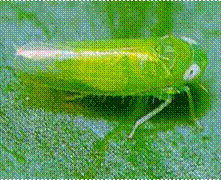 |
Symptoms of damage
- Tender leaves become yellow.
- The margin of the leaves start curling downwards and reddening sets in.
- In the case of severe infestation, leaves get a bronze or brick red colour which is typical “hopper burn” symptom.
- The margin of the leaves get broken and crumble into pieces when crushed.
- The leaves dried up and are shed and the growth of the crop is retarded.
Identification of the pest
- Nymph - Light green, translucent, wingless found between the veins of leaves on the under surface
- Adult - Green, wedge shaped leafhopper.
|
|
Management
ETL: 50 nymphs or adults/50 leaves
- Apply carbofuran 3%CG 25 kg/ha
Spray any one of the following insecticides
- Imidacloprid 200 SL at 100 ml/ha
- Phosphamidon 40 SL 600 ml/ha
- Acetamiprid 20%SP 50 g/ha
- Azadirachtin 0.03%WSP 500-1000 g/ha
- Buprofezin 25% SC 1000 ml/ha
- Clothianidin 50%WDG 30-40 kg/ha
- Diafenthiuron 50%WP 600 g/ha
- Dimethoate 30%EC 660 ml/ha
- Fipronil 5%SC 1500-2000 ml/ha
- Methyl demeton 25% EC 1200 ml/ha
- Phosalone 35%EC 857 ml/ha
- Profenofos 50% EC 1000 ml/ha
- Thiacloprid 21.7% SC 100-125 ml/ha
- Thiamethoxam 30% FS 10 kg/ha
- Thiamethoxam 25%WG 100 g/ha
- NSKE 5% 25 kg/ha
- Where the leafhopper is a big menace apply Neem oil formulation 0.5 % or neem oil 3% thrice at fortnightly
intervals.
|
| |
11. Cotton aphid: Aphis gossypii |
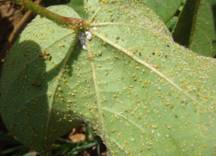 |
Symptom of damage
- Infesting tender shoots and under surface of the leaves.
- Curling and crinkling of leaves
- Stunted growth
- Blighted appearance when infestation is severe
- Development of black sooty mould due to the excretion of honey dew giving the plant a dark appearance
|

|
Identification of the pest
- Nymphs - Yellowish or greenish brown found on the undersurface of leaves.
- Adults - Greenish brown, soft bodied and small insects.
- Winged forms may be seen under crowded conditions.
|
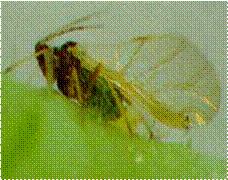 |
Management
ETL: 15% of infested plant
Spray any one of the following insecticides (500 l spray fluid/ha)
- Methyl demeton 25 EC 500ml/ha
- Dimethoate 30 EC 500ml/ha
- Acetamiprid 20%SP 50 g/ha
- Azadirachtin 0.03% EC 500 ml/ha
- Buprofezin 25% SC1000 ml/ha
- Carbosulfan 25%DS 60g/kg seed
- Chlorpyrifos 20% EC 1250 ml/ha
- Diafenthiuron 50%WP 600 ml/ha
- Dimethoate 30%EC 660 ml/ha
- Fipronil 5%SC 1500-2000 ml/ha
- Imidacloprid 70% WG 30-35 kg/ha
- Imidacloprid 17.8% SL 100 -125 ml/ha
- Malathion 50% EC 1000 ml/ha
- Methyl demeton 25% EC 1200 ml/ha
- Profenofos 50% EC 1000 ml/ha
- Thiacloprid 21.7% SC 100-125 ml/ha
- Thiamethoxam 25%WG 100 g/ha
|
| |
12. Thrips: Thrips tabaci |
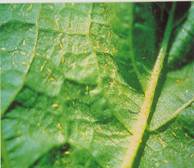 |
Symptom of damage
- Shriveling of leaves due to scrapping of epidermis and desapping
- Attacked terminal buds – have ragged edges
- Silvery shine on the undersurface of leaves
Identification of the pest
- Nymphs - Very minute, slender, yellowish and microscopic.
- Adult - Small, slender, yellowish to brown with fringed wings
|
 |
Management
ETL: 50 nymphs or adults/50 leaves
- Seed treatment with imidacloprid 70 WS at 7 g/kg protect the crop from aphids, leafhoppers and thrips upto 8 weeks.
Spray any one of the following insecticides (500 l spray fluid/ha)
- Methyl demeton 25 EC 500ml/ha
- Dimethoate 30 EC 500ml/ha
- Buprofezin 25% SC 1000 ml/ha
- Diafenthiuron 50%WP 600 g/ha
- Dimethoate 30%EC 660 ml/ha
- Fipronil 5%SC 1500-2000 ml/ha
- Imidacloprid 70% WG 30-35 g/ha
- Imidacloprid 48% FS/100kg seed 500-900 g/ha
- Imidacloprid 17.8% SL 100 -125 ml/ha
- Profenofos 50% EC 1000 ml/ha
- Thiacloprid 21.7% SC 100-125 ml/ha
- Thiamethoxam 70% FS 430 g/ha
- Thiamethoxam 25%WG 100g/ha
|
| |
13. Whitefly: Bemisia tabaci |
 |
Symptom of damage
- Chlorotic spots on the leaves which latter coalesce forming irregular yellowing of leaf tissue which extends from veins to the outer edges of the leaves
- Severe infestation results in premature defoliation
- Development of sooty mould
- Shedding of buds and bolls and poor boll opening
- It also transmits the leaf curl virus diseases of cotton.
|
Identification of the pest
- Nymph - Greenish yellow, oval in outline,
- Pupa - Puparia oval in shape, present on the under surface of the leaves.
- Adult - Minute insects with yellow body covered with a white waxy bloom.
|
|
Management
ETL: 5 - 10 /leaf
- Avoid the alternate, cultivated host crops of the white fly in the vicinity of cotton crop.
- Growing cotton only once a year either in winter or summer season in any cotton tract.
- Adopting crop rotation with non-preferred hosts such as sorghum, ragi, maize etc., for the white fly to check the build up of the pest.
- Removal and destruction of alternate weed hosts like Abutilon indicum, Chrozophore rottlari, Solanum nigrum
and Hibiscus ficulensus from the fields and neighbouring areas and maintaining field sanitation.
- Timely sowing with recommended spacing, preferably wider spacing and judicious application of recommended dose of fertilizers, particularly nitrogenous and irrigation management is essential to arrest the excessive
vegetative growth and pest build up. Late sowing may be avoided and the crop growth should not be extended
beyond its normal duration.
- Field sanitation may be given proper attention.
Cultivation of most preferred alternate host crops like brinjal, bhendi, tomato, tobacco and sunflower may be
avoided. In case their cultivation is unavoidable, plant protection measures should be extended to these crops
also.
- Monitoring the activities of the adult white flies by setting up yellow pan traps and sticky traps at 1 foot height above the plant canopy and also in situ counts.
- Collection and removal of whitefly infested leaves from the plants and those which were shed due to the attack of the pest and destroying them.
- Chemical control : Acetamiprid
20%SP 100 g/ha Azadirachtin 0.15%
500-1000 ml/ha Buprofezin 25% SC
1000 ml/ha Chlorpyriphos 20% EC
1250 ml/ha Clothianidin 50%WDG 40-
50 g/ha Diafenthiuron 50%WP 600
g/ha Fipronil 5%SC 250-340 ml/ha
- Imidacloprid 17.8% SL100 -125 ml/ha
- Profenofos 50% EC 1000 ml/ha
- Thiacloprid 21.7% SC 500-600 ml/ha
- Thiamethoxam 25%WG 100 g/ha
- Triazophos 40%EC 1500-2000 ml/ha
Spray any one of the following plant products alone or in combination with the recommended dose of insecticide (at 2 ml/l of water)
- Neem seed kernel extract 5% (50 kg) and neem oil at 5 ml/l of water
- Fish oil rosin soap 25 kg at 1 kg in 40 lit of water
- Notchi leaves 5% extract Catharanthus rosea extract 5%
Spray any one of the following in early stage (500 l of spray fluid/ha)
- Phosphamidon 40 SL 600 ml/ha
Spray any one of the following in mid and late stages (1000 l spray liquid/ha) Triazophos 40 EC 2.0 l/ha
- In the early stages with high volume sprayer, use a goose neck nozzle to cover the under surface of the foliage to get good control of the pest. If high volume sprayers are not available, 375 litres of spray fluid may be used per hectare for application in the low volume motorised knapsack mist blower.
- The use of synthetic pyrethroids should be discouraged in cotton to avoid the problem of whitefly.
- Cypermethrin, fenvalerte and deltamethrin cause resurgence of whiteflies.
- So avoid repeated spraying of pyrethroids.
- The plant protection measures should be adopted on a community basis in a specified cotton areas.
- Biological control: Verticillium lecanii 1.15% WP 2500 g/ha
|
| |
| 14. Red cotton bug: Dysdercus cingulatusi |
 |
Symptom of damage
- Red stained lint and rotting bolls.
- Inner boll wall with warty growth or water soaked spots
- Young bolls abort and turn dark brown
- The bacterium Nematospora gossypii enters the site of injury and stains the fibre.
Identification of the pest
- Nymphs and Adults - Reddish bugs with white bands on the abdomen and black markings on the wings.
|
|
Management
- Plough the field to expose the eggs.
- Spray phosphamidon 100 EC@250 ml/ha
|
| |
| 15. Dusky cotton bug: Oxycarenus hyalinipennis |
 |
Symptom of damage
- Sucks the sap from developing seeds in open bolls and stains the lint black.
- Seeds discolored and shrunken.
|
|
Identification of the pest
- Eggs - Cigar shaped, white eggs in clusters of 2-10 within the half opened bolls, on the bolls, flower or buds
- Nymphs and adults - Dusky, greyish brown bug, with pointed head and hyaline wings
Management
- Spray phosphamidon 100 EC@250 ml/ha
|
| |
| 16. Mealy bugs: Phenacoccus sp, Ferrisa sp and Maconellicoccus sp |
 |
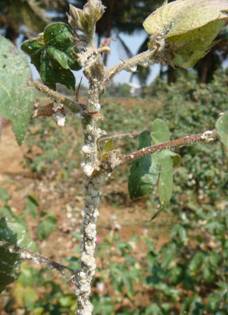 |
Symptom of damage
- Heavy clustering of mealy bugs usually seen under surface of leaves as a thick mat with waxy secretion.
- Excrete copious amount of honey dew on which the fungus sooty mould grow.
- Affected plants appear sick and black, resulting reduced fruiting capacity.
- Management
Remove the alternate weeds hosts
- Monitor the incidence regularly and look for crawler emergence
- Take up the management at intial stage to get maximum control
- Wherever necessary use botanical insecticides like neemnderivatives such as neem oil 2% NSKE 5% and Fish oil rosin soap 25g/litre of water.(Consult the specialists for effective chemicals for individual species)
- Use of Encyrtid parasitoids, Acerophagus papayae @ 100 per village against Paracoccus marginatus and Aenasius bambawaeli against Phenococcus solenopsis are recommended.
- Use of dimethoate or profenophos @ 2ml / lit. may be adopted as an alternative
|
Infested plants |
Mealy bugs on stem |
|
|
|
|

